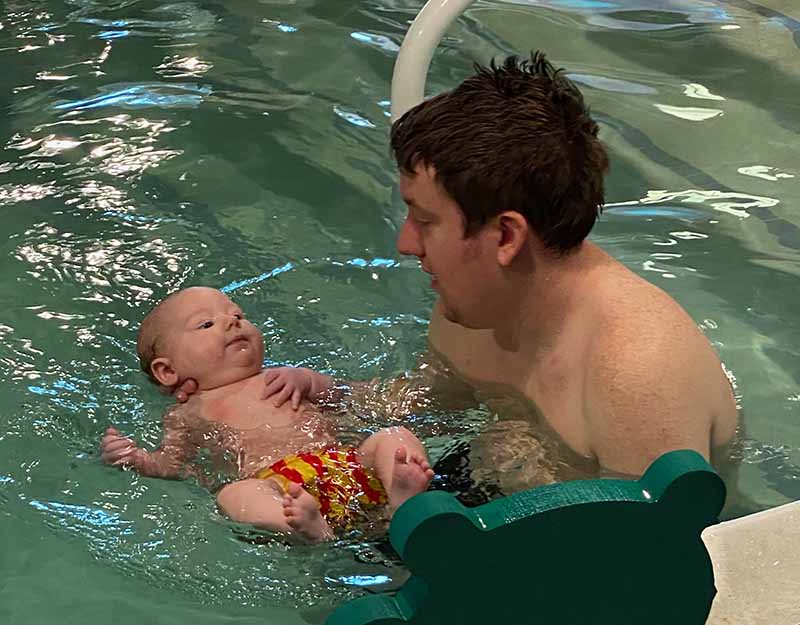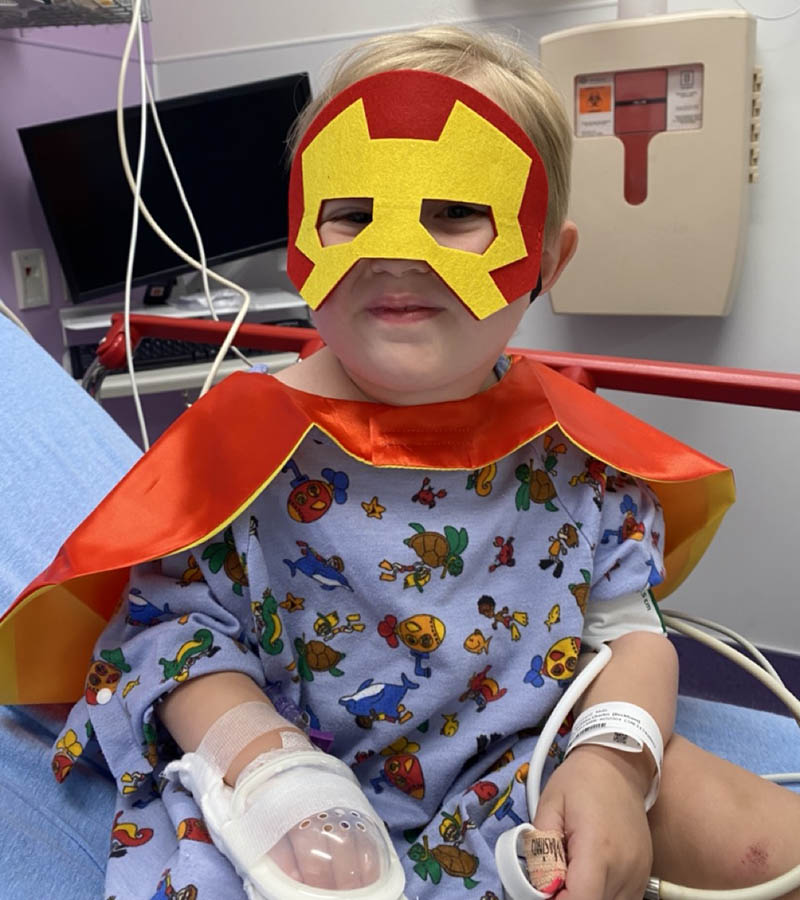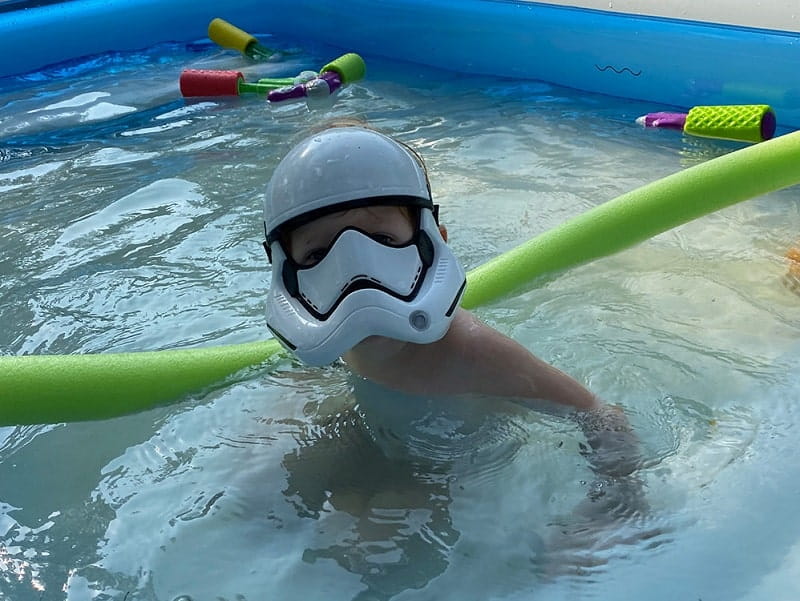He went from troubleshooting a CPR training app to using CPR to save his 2-year-old son
By Jaime Aron, American Heart Association News
Buckled into the driver's seat, on his way to a Dallas hospital, Tyler Morgan put his phone's video camera into selfie mode and hit record.
Peeking his reddened eyes toward the lens, he started talking.
"So, my, my son almost … just … drowned. Or he did drown. He almost just died."
The Morgans were at a social gathering when 2-year-old Beckham saw a foam noodle floating in an Olympic-sized pool. Because of lightning, the pool was off-limits. But Beckham has always been both fearless and attracted to water. So, with no one looking, this boy whose swimming training ended when he was 5 months old because of the COVID-19 pandemic, went in after that noodle.

He walked down a couple of steps and reached out for it. Instead, his little hands pushed it away. Beckham chased after the noodle again, only this time in water deeper than he could handle.
A teenager was the first to notice Beckham floating face down. She jumped in, pulled him out and placed him on his back alongside the edge of the pool. His body was lifeless. His face was purple. She and two teen boys started screaming.
From about 30 feet away, Tyler heard the commotion off to his right. He turned toward it. Because of tables and people in the way, all he could see were a pair of tiny legs wearing black swimming trunks with a thin green-yellow stripe down the side and black sandals.
Recognizing those trunks and sandals, Tyler raced over.
"Nobody knew what to do," he said into the camera, slightly shaking his head and shrugging.
With a bigger head shake and a shrug, he added: "Kind of myself included."
Yet when Tyler reached Beckham, he knew exactly what to do.
Tyler pointed at someone and told them to call 911, then he started pushing hard and fast in the center of his son's chest. After a series of compressions, Tyler paused to check if Beckham was breathing. He wasn't. So Tyler began giving rescue breaths between compressions.
Rescue breaths are especially vital when giving CPR to children whose hearts have stopped because the root cause is usually respiratory. Tyler continued alternating breaths and compressions for about 20 seconds. Then Beckham coughed.
Although he was breathing again, Beckham remained unresponsive. So Tyler used a single knuckle to rub the boy's sternum. With that jolt, Beckham began crying loudly and breathing deeply.
By the time an ambulance arrived, Beckham was wrapped tight in the arms of his mom, Jessica Morgan. Once paramedics took over caring for the boy, a woman grabbed Tyler and said: "You did it, Papa! I'm a nurse and I saw the whole thing. I couldn't have done it any better."
Of all the pieces that snapped into place to save Beckham's life, the most remarkable is how and why Tyler knew what to do.
Tyler is vice president of engineering for Trivie, a company that went from making the best-selling game in an app store to working with companies on their own training programs. Trivie applies its neuroscience-based trivia contests to those programs so critical information will be remembered longer. For the last few years, Trivie has worked with the American Heart Association to develop a Knowledge Booster app that – as the name implies – offers training reinforcement for CPR and other lifesaving skills. It launched in January.
Following a major update of the app in March, Tyler scoured the app to make sure everything looked good and was performing well. On Saturday, April 9, he spent so much time working on it that he promised his family he'd take off Sunday, in part to join them at this pool party.
As part of his evaluation, Tyler went through every screen many times. This included reviewing each question even more often. His sole focus was making the app work perfectly. At least, he thought that was his sole focus.
"Because of just the cursory knowledge that I've gained from using that app – in testing, even – I knew enough to … to … save his life," Tyler said in the video, his voice cracking on those last few words. Then he sniffed, winced, looked back at the road and put his hand over his mouth as he tried to regain his composure.
Each year, more than 350,000 people in the U.S. go into cardiac arrest outside of a hospital. About 90% die.
The odds are terrible in part because of how seldom those people receive bystander CPR: only about 40%. When CPR is performed immediately, survival is up to three times more likely.
Statistics, however, can only go so far in convincing people to learn CPR. Far more persuasive is a story of how things can play out. This story is even more gripping because of the video that lets everyone see and hear the emotions of this dad-lifesaver in the moments after reviving his son and before learning his prognosis.
By the time paramedics loaded Beckham into the ambulance, survival wasn't the concern. Quality of life was. Nobody knew how long he'd gone without oxygen; was it enough to cause brain damage? There also was the unknown of what other injuries he might've sustained.
The ambulance could only take one passenger. Jessica went, leaving Tyler to drive himself. He zoomed through traffic, his blinkers flashing as a siren-like warning to other drivers. Along the way, Tyler called his mom, then his dad. Then he called Trivie's CEO Lawrence Schwartz.
Although Tyler was one of the first employees when Schwartz launched the company 10 years ago, they aren't social friends outside of work. Still, Tyler felt compelled to let him know what happened. Among all the things Tyler was processing, he vaguely grasped that Beckham was alive thanks to a series of events triggered by Schwartz.
Schwartz is a stroke survivor who credits the American Heart Association for helping with his recovery. When Trivie scientifically validated its approach to learning, he reached out to the AHA to apply the company's knowledge-retention tools into a CPR and first aid app. While this started as Schwartz's passion project, the idea that Trivie's software could save a life appealed to all his programmers, including Tyler.
Schwartz was pulling into a restaurant parking lot for dinner with his two daughters when he received Tyler's call.
After blurting out what happened, Tyler told Schwartz they needed to do all they could to get the app to more people. That's when Schwartz suggested he record a video.
"Take a video of what you did and how you did it," Schwartz told Tyler. "This could help save another life."
He recorded for about 3 minutes. Soon after, he arrived at the hospital and hurried into the emergency room.
He found Beckham sitting up in bed, smiling wide and wearing a superhero mask and red cape.

Right away, Tyler knew Beckham was still Beckham, still the precocious kid he'd always been.
Beckham spent that night in the hospital merely for observation. The next day, his pediatrician gave him a clean bill of health.
Days later, the Morgans went back to the pool. The main reason was to thank the girl who pulled Beckham out of the water, giving her a happy memory to replace the vision of him being unconscious and purple. Tyler and Jessica also were curious to see how Beckham would respond to being back at the facility.
"He went running by the pool, laughing at it like, 'Look at me! I'm not scared!'" Tyler said. "Granted, this time, I was stuck to him like a magnet."

The emotional core of this story is the dual roles played by Tyler.
He's a father who almost lost his son. And he's a 37-year-old man who brought a 2-year-old boy back to life.
Maybe he should be the one wearing a superhero mask and red cape.
"The only thing I need is to know that he's OK," Tyler said. "That's the reward. That's the prize. My son still exists, and the rest of our lives is not ruined.
"This thread of the multiverse is the one where I get to continue living with my son."
June 1-7 is CPR and AED Awareness Week. The Morgans chose this time to share their story because it highlights the importance of knowing how to save a life and how easy it is to learn the necessary skills. Once those skills are learned, the AHA Knowledge Booster app can help retain the information. It is available for iOS, Android and desktop devices.
If you have questions or comments about this American Heart Association News story, please email [email protected].





